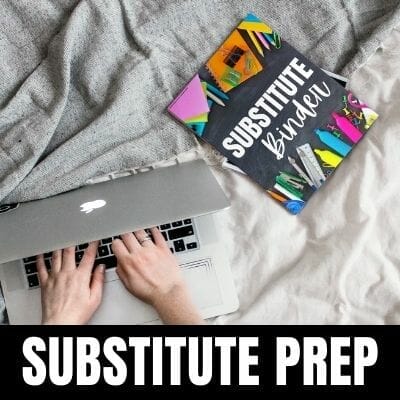The First-Time Mentor Teacher’s Guide: Advice for Mentoring a Student-Teacher
Are you stepping into the mentor teacher role for the first time, gearing up to collaborate with a student-teacher? If so, you might feel a little bit like a first-year teacher all over again – a dash of excitement mixed with a pinch of nervousness and a heap of responsibility. Trust me, we’ve all been there. Embarking on this mentorship journey is like setting up your classroom for a new school year. Just as you’d carefully arrange desks and plan engaging lessons, guiding a student-teacher requires preparation, strategy, and some elbow grease.

But don’t worry! You’re not alone in this.
I’m here to walk you through this process, sharing some hard-earned wisdom and practical tips to set you on the path to successful collaboration.
As first-time mentor teachers, you have a unique opportunity to shape tomorrow’s educators, share your experiences and knowledge, and learn something about yourself along the way. It’s an experience that’s as rewarding as it is challenging.
So, buckle up, my teaching comrades! It’s time to dive into the world of mentorship, explore the ins and outs of effective student-teacher collaboration, and navigate this exciting new chapter together. Let’s get started, shall we?
Understanding Your Role as a Mentor Teacher
Before we get into the nitty-gritty of strategies and tips, let’s take a moment to understand what it really means to be a mentor teacher. Sounds simple, right? But you’d be surprised how this role can be as multifaceted as a well-cut gem.
As a mentor teacher, you’re more than just an experienced educator; you’re a guide, a coach, and yes, sometimes even a cheerleader.

You’re stepping into the shoes of someone who can shape a budding teacher’s journey, offering them valuable insights gleaned from your years in the classroom.
But remember, this role isn’t just about teaching classroom management or lesson planning skills – though they are important. It’s also about nurturing confidence, fostering professionalism, and instilling a passion for teaching in your student-teacher. You’re their go-to person, their first port of call when they have doubts, need advice or just want to share a successful lesson or a classroom win.
Being a mentor teacher is not a one-way street; it’s a dynamic, reciprocal relationship. Yes, you’re there to guide and support, but it’s also an opportunity for you to learn, gain fresh perspectives, and reflect on your own practices.
Navigating this role can sometimes feel like a juggling act, balancing your regular teaching responsibilities with your mentorship duties. But don’t fret – with the right approach and mindset, you’ll soon find your rhythm. And remember, every great mentor teacher was once a beginner, just like you. So let’s take this journey step by step, starting with understanding and building strong student-teacher relationships. Ready to take the plunge?
Navigating Student-Teacher Relationships
Alright, let’s talk relationships – student-teacher relationships, that is. Now, you might be thinking, “I’ve managed relationships with my students for years, this will be a breeze!” But, just as a jazz dance differs from a waltz, the dynamics of a student-teacher relationship can be quite different from those with your students.
You see, in this partnership, you’re the teacher, mentor, and guide. You’re working with adults just on the cusp of launching their teaching careers. They’re enthusiastic, full of questions, eager to learn, and a little apprehensive, like any of us starting something new. Your role? To be their compass, helping them navigate the vast and exciting real-world situations they’ll face in the classroom.
Set clear expectations.
Building a strong, positive relationship with your student-teacher starts with setting clear expectations. From the get-go, be open about your teaching philosophy, classroom rules, and expectations for their role. Encourage them to do the same. This open communication can lay a strong foundation for a productive mentorship.
Create an atmosphere of trust & mutual respect.
Next, foster an atmosphere of trust and respect. Remember, it’s okay for your student-teacher to make mistakes – they’re here to learn, just like your students. Guide and support them, but also allow them the space to find their teaching style.
Focus on clear, open lines of communication.
And, don’t forget to listen! Effective mentorship is not just about giving advice but also about being open to their ideas, their concerns, and their aspirations. Encouraging this two-way communication can lead to a deeper understanding and a more enriching mentorship experience for both of you.
Remember, you’re not just guiding a future teacher. You’re also building a professional relationship that could last for years. So, let’s keep these pointers in mind as we sail through this journey, fostering a relationship rooted in mutual respect, trust, and a shared passion for teaching. On to the next stop: creating a positive learning environment!
Creating a Positive Learning Environment for Student-Teachers
Just as you painstakingly curate a welcoming, engaging learning environment for your students, your student-teacher also deserves a positive and nurturing space to learn and grow. But this time, we’re talking beyond vibrant bulletin boards and neatly arranged desks. We’re delving into an atmosphere that breathes positivity, encourages exploration, and fosters professional growth. Here are some steps that will help:
Create a welcoming environment.
To create this ideal learning environment, start by making your student-teacher feel like a part of the team. Welcome them not just into your classroom, but also into your school community. Introduce them to other teachers, involve them in school-wide activities, and encourage them to observe other classrooms. This sense of belonging can boost their confidence and enhance their learning experience.
Encourage open & honest feedback.
Next, make room for open and honest feedback. As we need our morning coffee, student-teachers crave constructive feedback – their fuel for growth. When giving feedback, strike a balance between praise and constructive criticism. Highlight their strengths, appreciate their efforts, and guide them through their areas of improvement. Remember, the goal is not to critique, but to foster reflection and improvement.
Encourage curiosity and creativity in your student-teacher. Allow them to experiment with teaching strategies, take risks and learn from their experiences. But, be there to support them, to steer them when they veer off course, and to celebrate their successes, no matter how small.
Finally, be patient and empathetic. Transitioning from a student to a teacher can be a rollercoaster ride filled with excitement, nervousness, and, sometimes, a sprinkle of self-doubt. Understand their challenges, empathize with their struggles, and assure them that it’s okay to ask for help.

Creating a positive learning environment for your student-teacher is not a one-time task; it’s an ongoing process. It’s about fostering a culture of mutual respect, continuous learning, and unwavering support. With this conducive atmosphere in place, let’s venture further into our mentorship journey, focusing on effective collaboration with our student-teachers. Shall we?
Collaborating Effectively with Student-Teachers
It’s time to get down to business. We’ve understood our role, built strong relationships, and created a positive learning environment. Now, let’s dive into the heart of mentorship: collaboration. Because let’s be real, being a mentor is not a solo gig, it’s a beautiful duet with your student-teacher, and it’s time to choreograph that dance together.
Communication
First up, let’s talk about communication, the lifeblood of collaboration. Effective, open, and regular communication is key to understanding and guiding your student-teacher. Schedule frequent check-ins to discuss their progress, address any issues, and provide constructive feedback. Don’t limit these to formal meetings – casual chats over a cup of coffee or during lunch breaks can be equally, if not more, effective.
Co-teaching & Collaboration
Next, emphasize co-planning and co-teaching. Allow your student-teacher to participate in lesson planning, gradually increasing their involvement. Not only does this give them hands-on experience, but it also allows them to model effective planning strategies. When it comes to teaching, start by letting them observe you. Then, move to co-teaching, and eventually, hand over the reins to them while you observe and guide.
Remember to involve your student-teacher in more than just teaching. Classroom management, parent communication, and grading assignments – these are all integral parts of a teacher’s role. Involve your student-teacher in these aspects, providing guidance and feedback along the way.
Don’t forget – collaboration is a two-way street. While your student-teacher has a lot to learn from you, they can also offer fresh perspectives and new ideas. So, be open to learning from them, to being inspired by their enthusiasm and creativity.

Effective collaboration doesn’t happen overnight. It’s built on mutual respect, clear communication, and shared responsibilities. It’s about working together to develop a competent, confident, and compassionate teacher. With these collaborative efforts, we’re one step closer to that goal.
Ready for the next chapter in our mentorship journey? Let’s explore how to help student-teachers develop their teaching skills. Onward, we march!
Helping Student-Teachers Develop Their Teaching Skills
Now, we’re stepping into the core of teaching – skill development! Much like master gardeners tend their plants, mentor teachers must nurture and cultivate their student-teachers’ abilities. From lesson planning to classroom management, every aspect needs attention and care. So, let’s dive into the how-to’s and get those teaching skills blossoming!
Lesson Planning
Lesson planning is a crucial skill for any teacher, and this is where you can truly shine as a mentor. Share your planning process, your resources, and your strategies. Walk them through creating lesson objectives, designing activities, differentiating instruction, and assessing learning. Remember, the aim is to not just teach them to plan a lesson, but to design engaging, meaningful learning experiences. The experiences they likely had in their college classroom are often quite different from the reality of the real-world.
Classroom Management
When it comes to classroom management, model how to create a safe and inclusive environment. Share your strategies for setting rules, managing behavior, and fostering respect. Let them observe you, let them practice under your guidance, and gradually, let them take the lead.
Teaching isn’t just about delivering content; it’s about engaging students, sparking curiosity, and fostering understanding. Show your student-teacher how to use questioning strategies, how to incorporate real-world connections, and how to use technology effectively. Encourage them to experiment, to find their own teaching style, and to reflect on their practice.
Assessment
Assessment is another crucial skill in a teacher’s toolkit. Guide your student-teacher in designing assessments, providing feedback, and using assessment data to inform instruction. Stress the importance of both formative and summative assessments, and show them how each serves a different purpose in the learning process.
Reflection
And, of course, don’t forget the power of reflection. Encourage your student-teacher to reflect on their lessons, classroom management, assessments, and teaching. As we all know, reflection is the cornerstone of growth and improvement in our teaching journey.
Focusing on these key skills and providing ongoing, constructive feedback can help your student-teacher grow from a novice into a confident, competent educator. It’s a slow and gradual process, but trust me, it’s rewarding. So, let’s keep nurturing, keep guiding, and keep marching forward on this mentorship journey. Up next: dealing with challenges in mentorship. Shall we?
Challenges of Being a First-Time Mentor Teacher
Finally, let’s tackle the not-so-glamorous side of mentorship – the challenges. It’s no secret that stepping into the mentor-teacher role can feel like setting foot on a tightrope.
Balancing your teaching responsibilities with your mentorship duties, figuring out how to guide without overpowering, and navigating the delicate dynamics of a mentor-mentee relationship can feel like quite the balancing act.

As a first-time mentor, it’s natural to feel a sense of apprehension, even doubt. You might worry about finding the right balance between guiding your student-teacher and allowing them space to grow.
Or you might wonder if you’re providing enough support or if you’re adequately addressing their needs. You might even grapple with time management, trying to juggle your classroom duties with your new mentorship role.
But remember, these challenges don’t define your mentorship journey; they shape it. They are not roadblocks, but stepping stones on your path to becoming an effective mentor. With each challenge you navigate, you’re not only honing your mentorship skills, but you’re also becoming a better teacher, a better learner, a better leader.
Frequently Asked Questions About Being a Mentor Teacher
1. What if my teaching style conflicts with that of my student-teacher?
It’s important to remember that each teacher has their unique teaching style. Encourage your student-teacher to develop their approach while adhering to effective teaching practices. Dialogue and understanding are key in resolving any potential conflicts.
2. How should I handle a situation where my student-teacher is not receptive to feedback or advice?
In such cases, it’s important to promote a growth mindset. Encourage open communication, emphasizing that feedback is a tool for improvement and growth. If resistance persists, consider seeking advice from a school counselor or administrator.
3. What if my student-teacher commits a serious error or mistake?
Mistakes can be powerful learning opportunities. Discuss the issue with the student-teacher constructively, focus on what can be learned from the experience, and collaborate to find solutions. If the mistake is serious or puts a student at risk, involving a school administrator or the student-teacher’s university supervisor might be necessary.
4. What if I don’t feel competent or confident enough in my own abilities to mentor a student-teacher?
Mentoring can be a learning experience for both parties involved. Remember, nobody expects you to be perfect. Focus on providing the best guidance you can, and don’t hesitate to seek advice from other experienced mentors or professional development resources.
5. How do I address a situation where my student-teacher seems to be struggling with classroom management?
It can be helpful to model effective classroom management strategies and discuss these techniques with your student-teacher. Provide them with resources and specific, constructive feedback on what they might do differently. Role-playing difficult situations might also be beneficial.
6. What if the students in my class are not responding positively to my student-teacher?
Open a discussion with your student-teacher about what they have observed and experienced. Together, come up with strategies to improve student interactions and engagement. It could also be valuable to discuss the issue with the class in an age-appropriate manner.
Wrap Up: The best advice for mentoring a Student Teacher
And there we have it, a crash course in guiding the leaders of tomorrow’s classrooms and helping student-teachers succeed. From understanding your role as a mentor teacher to fostering relationships, creating a conducive learning environment, and effectively collaborating with your student-teacher, we’ve journeyed through the many facets of mentorship.
There might be bumps along the way, and that’s okay. Remember, every challenge is an opportunity for growth, for learning. So, embrace these moments, relish the journey, and keep the ultimate goal in sight – to shape a student-teacher into a confident, competent, and compassionate educator.
As you embark on this rewarding journey, remember that you’re not alone. Lean on your colleagues, draw from your experiences, and never stop learning. Because, at the end of the day, the most effective mentor is one who is a lifelong learner.
So, go forth, and make a difference – not just in the lives of your students, but in the lives of future educators. And remember, in this dance of mentorship, it’s not just about leading; it’s also about learning, growing, and, most importantly, enjoying the rhythm. Until next time, keep teaching, keep learning, and keep inspiring!







